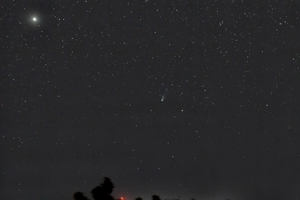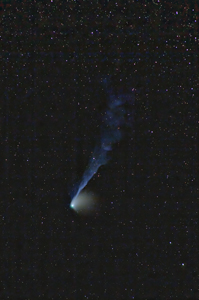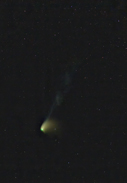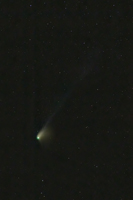 |
2024 April 1: photographed
under light-polluted
skies from Fort Stockton, Texas, USA,
against the stars of
Aries when it was about magnitude 4.8*; tripod-mounted Canon 5D MkII + 28-70mm
f2.8
zoom lens, at 63mm and f4, ISO2000. Seventy-four
x 5 sec exposures were stacked and combined for just over 6 minutes of total
accumulation. Field of view ~24°x16°.
* COBS database: https://www.cobs.si/obs/comet/484/ |
|
2024 April 30: photographed
under dark skies near
Echuca, northern Victoria, against the stars of
Taurus when it was about magnitude
4.8*, though atmospheric extinction was substantial due to low elevation of 15º; Canon 5D MkII + 300mm
f/2 lens, at f4, on an NEQ6 Pro mount tracking the sky, ISO 1600. Thirty
seven x 20 second exposures were stacked and combined to optimise the comet and
the background stars; total accumulation = 12.3 minutes. Field of view
~3.9°x2.6°..Note the
beautifully structured blue ion tail.
* COBS database: https://www.cobs.si/obs/comet/484/ |
|
| 2024
May 1; magnitude about 4.9* against the stars of Taurus,
though atmospheric extinction was substantial due to low elevation and poor transparency;
location and equipment as per April 30. Thirty six x 20 second exposures
were stacked and combined to optimise the comet and
the background stars; total accumulation = 12 minutes. Field of view
~3.9°x2.6°.
Note the blue ion tail is present, but was impacted by the adverse
observing conditions.
* COBS database: https://www.cobs.si/obs/comet/484/ |
|
| 2024
May 2; magnitude about 4.9* against the stars of Taurus,
though atmospheric extinction was substantial due to low elevation and poor
transparency;
equipment as per April 30. Thirty eight x 20 second exposures stacked and combined to optimise the comet and
the background stars; total accumulation = 12.6 minutes. Field of view
~3.9°x2.6°.
* COBS database: https://www.cobs.si/obs/comet/484/ |
|
|
2024 May 27; photographed
under dark skies at
Beechworth, northern Victoria, against the stars of
Lepus
when at magnitude about 5.9*;
equipment as per April 30. Fifty x 30 second exposures were stacked and combined to optimise the comet and
the background stars; total accumulation = 25 minutes. Field of view
~5.3°x3.5°.
The comet's appearance has changed dramatically over the month, but the change is simply an effect of perspective as we see the comet almost edge-on as the Earth passes through the comet's orbital plane. * COBS database: https://www.cobs.si/obs/comet/484/
|



-port-tn.jpg)